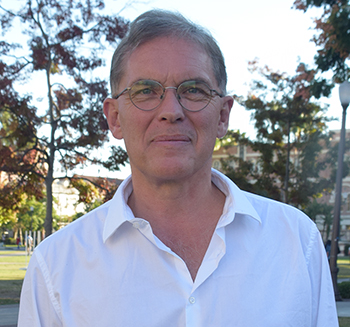
Therkel Straede
Danish historian Therkel Straede spent three days at USC Shoah Foundation Center for Advanced Genocide Research this week watching testimonies in an attempt to understand the truth about one of the most gruesome and taboo aspects of the Holocaust: cannibalism in the Nazi concentration camps.
Straede, Professor of Contemporary History at the University of Southern Denmark, decided to extend his stay in Los Angeles while attending the Lessons and Legacies conference at Claremont McKenna College by spending three days at USC Shoah Foundation to conduct research in the Visual History Archive.
The article he is planning to write is, Straede admits, quite dark. Along with sexual violence, cannibalism in the German concentration camps of World War II is one of the least spoken about aspects of the Holocaust. Video testimonies of witnesses in the Visual History Archive are crucial to understanding what actually happened, and why.
“The idea for me to come [to USC Shoah Foundation] was for me to find out what we can learn about this topic from what the survivors are telling,” Straede said. “I’m going through all the various aspects of it. Who was eating who, what is being eaten, how is it being eaten, and also what are the feelings of the survivors toward the question [of cannibalism]. That’s very readable through body language and the pauses that they make.”
Straede has found over 500 mentions of cannibalism in the Visual History Archive in a range of languages, including English, Swedish, Russian, French, Spanish and Slovak. Most of the incidents took place in the last two months before liberation, when some starving prisoners, allegedly, prepared food with the flesh of SS guards who had just been killed by enemy fire.
From the testimonies in the Visual History Archive, Straede has learned that there were actually very few instances of cannibalism, despite the mythical idea that it was rampant throughout the concentration camps.
“We’re talking about very few specific camps and some very few specific episodes which many people have witnessed and which for that reason the knowledge of them has spread out and given the impression of a more widespread phenomenon than it probably was,” Straede said.
While many interviewees describe seeing fellow prisoners engaging in cannibalism, very few admit to having actually participated themselves, he said. Most survivors express complete revulsion and incredulity that their fellow prisoners could do such a thing even under such desperate circumstances – though from their body language, Straede suspects that some aren’t being truthful when they deny having participated.
“It’s interesting on the philosophical level where the human being is actually drawing this line because it’s such a strong taboo and it’s a very strong taboo in the camps, otherwise I wouldn’t have 500-some pieces of testimony, I would have 5,000,” Straede said. “Many of them have huge problems facing the fact that somebody who wasn’t themselves would do a thing like that, even in that [extreme] situation where you eat grass and leaves from trees.”
Straede noted that survivors tend to stereotype who engaged in cannibalism, and it’s always “the other.” European Jews claimed it was the Russians who did it, Russians blame Ukrainians, German Jews say it was Poles. But through testimony, Straede is able to build a more complete picture of what really happened, as told by people from all walks of life and backgrounds who were there.
“[The Visual History Archive] provides you the possibility of hearing a multitude of very varied voices, and the search system is fantastic because it makes it possible for you to make cross-cultural comparisons,” he said. “If you have enough [testimonies to work with] it makes it possible to come closer to the actual events without being naïve. A lot of things have to be taken into account when you interpret the stuff. But it’s such a richness of material.”
Historians have tended to stop short of sexual violence and cannibalism when studying the Holocaust, but Straede said it is important to study the complete scope of the Nazi terror.
Through his research of cannibalism, Straede wants to consider how the practice of cannibalism in the last months of the war confirms or rejects Nazism’s attempt to destroy the humanity of the persecuted people. Did Nazism push people to the point in which even the strongest cultural norms can be put aside in order to survive?
“Is the prisoner being reduced to mere physical existence? Are all ethical and cultural values and morals really being eradicated through the Nazi terror, did the Nazis succeed in doing that?” he said. “Is the habitus from before you became a prisoner so strong that you uphold a taboo which is purely cultural even if this means you will be going to your death for not breaking it?”